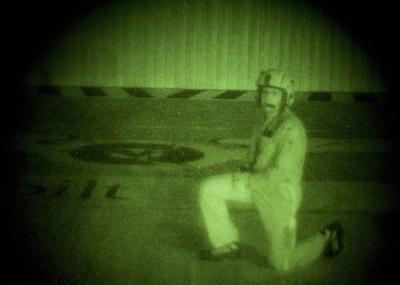Vanderbilt LifeFlight is now using technology once reserved for military operations or secret spy missions.

Tim Hurst, R.N., E.M.T., poses for a photo taken through LifeFlight's new night vision goggles. (Credit: Photo by Joe Howell)
With the ability to enhance light 10,000 times, the air ambulance service's new night vision goggles essentially turn night into day.
"You can see a lit cigarette 10 miles away," said Wilson Matthews, R.N., E.M.T., chief flight nurse for LifeFlight's base in Lebanon, Tenn., who is part of the night vision transition. "You go from seeing nothing to seeing the texture of tree leaves."
Matthews said night vision will be most useful when making scene landings because pilots and nurses will be able to see the trees, power lines, rising terrain and other hazards on the ground.
"Night vision is absolutely amazing. I have been at LifeFlight since 1997, and this is the single best thing we have done to enhance safety," he said.
Because military demand had dropped, this is the first time that the goggles are available to civilian aviation operations.
Three of LifeFlight's four bases are already using night vision, and the final base should be trained by early 2010.
A five-hour training program is required for pilots and nurses, and pilots have additional required hours of use in the sky, including take-off, landing, emergency procedures and transitioning between night vision and regular vision.
Night vision works by gathering ambient light from the moon, stars or distant light sources into a special tube. The tube enhances the energy level of the light and hurls the particles at a phosphorus screen that creates the amplified image seen through the eyepiece.
Night vision is known for its eerie green hue. That color was chosen because the eye can differentiate more shades of green than any other color.
Pilot Mike Cobb dons the new night vision goggles. The goggles look like binoculars and are mounted on the front of the helmet. Matthews said one disadvantage is the loss of peripheral vision.
"It's like looking through two tubes," he said. "Pilots also have to transition from looking through night vision to looking down at the instrument panel with regular vision. They are also heavy on the helmet and can give you a sore neck the next day."
Matthews cautioned that night vision will not allow LifeFlight to make flights that were deemed too risky in the past, but it will greatly enhance the safety of their current capabilities.
"LifeFlight will still have to say no when the weather is bad or we can't land safely, but night vision is a huge step forward for us. We can be more confident in our landings and put more focus on great patient care," he said.
Story Source:Adapted from materials provided by Vanderbilt University Medical Center.
(责任编辑:董静)